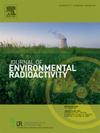Sorption of Se(IV) on Gaomiaozi bentonite: Batch and spectroscopic studies
IF 2.1
3区 环境科学与生态学
Q3 ENVIRONMENTAL SCIENCES
引用次数: 0
Abstract
Se-79 is regarded as one of the scarce radionuclides with a protracted half-life. Exploring the sorption behaviors of selenium on bentonite is critical for the safe disposal of radioactive waste. The sorption of Se(IV) on Gaomiaozi bentonite at a low concentration (7 × 10−8 M) was systematically studied to set reliable parameters in this work by batch sorption method and spectroscopic techniques. The factor of pH, ionic strength, initial Se(IV) concentrations, solid-to-liquid ratio and the addition of uranyl ions were investigated. The sorption results indicate that Gaomiaozi bentonite exhibited remarkable sorption capacity towards selenium under conditions of acidic pH and high ionic strength. The XPS spectra reveal that Se(IV) remains stable on bentonite surface and there is no redox reaction observed between Se(IV) and bentonite. The possible sorption mechanism is interpreted based on species calculation and photon correlation spectroscopy. In detail, the positively charged electric double layer surrounding the surface of the lamellae will “spill over” when the ionic strength is low, thereby encircling the edge site area of bentonite. Therefore, the selenium anion is difficult to enter, leading to a low sorption capacity. The aggregation state of bentonite particles does not primarily govern the sorption behavior of Se(IV). Overall, this work may provide valuable information on sorption mechanism of Se(IV) at the bentonite/water interface and help us understand the geochemical behaviors of Se(IV) in repository environments.

高庙子膨润土对硒(IV)的吸附:批处理和光谱研究
硒-79被认为是半衰期较长的稀有放射性核素之一。研究膨润土对硒的吸附行为对放射性废物的安全处理具有重要意义。采用间歇吸附法和光谱技术,系统研究了低浓度(7 × 10−8 M)高庙子膨润土对Se(IV)的吸附,并建立了可靠的吸附参数。考察了pH、离子强度、初始Se(IV)浓度、料液比和铀酰离子添加量等影响因素。结果表明,在酸性pH和高离子强度条件下,高庙子膨润土对硒具有显著的吸附能力。XPS光谱结果表明,Se(IV)在膨润土表面保持稳定,未发生氧化还原反应。基于种计算和光子相关光谱对可能的吸附机理进行了解释。当离子强度较低时,围绕在片层表面的带正电荷的双电层会“溢出”,从而包围膨润土的边缘位点区域。因此,硒阴离子难以进入,导致吸附能力低。膨润土颗粒的聚集状态并不是决定Se(IV)吸附行为的主要因素。综上所述,本研究为研究膨润土/水界面上Se(IV)的吸附机理提供了有价值的信息,并有助于我们了解Se(IV)在储层环境中的地球化学行为。
本文章由计算机程序翻译,如有差异,请以英文原文为准。
求助全文
约1分钟内获得全文
求助全文
来源期刊

Journal of environmental radioactivity
环境科学-环境科学
CiteScore
4.70
自引率
13.00%
发文量
209
审稿时长
73 days
期刊介绍:
The Journal of Environmental Radioactivity provides a coherent international forum for publication of original research or review papers on any aspect of the occurrence of radioactivity in natural systems.
Relevant subject areas range from applications of environmental radionuclides as mechanistic or timescale tracers of natural processes to assessments of the radioecological or radiological effects of ambient radioactivity. Papers deal with naturally occurring nuclides or with those created and released by man through nuclear weapons manufacture and testing, energy production, fuel-cycle technology, etc. Reports on radioactivity in the oceans, sediments, rivers, lakes, groundwaters, soils, atmosphere and all divisions of the biosphere are welcomed, but these should not simply be of a monitoring nature unless the data are particularly innovative.
 求助内容:
求助内容: 应助结果提醒方式:
应助结果提醒方式:


